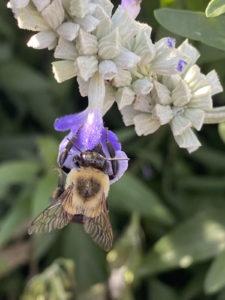How to Bee Helpful to Pollinators

By Anna Fairbanks, Agriculture and Water Outreach Specialist Individual Placement / AmeriCorps member placed with Cottonwood SWCD

Spring is here! April is National Native Plant Month! In honor of Native Plant month, I want to bring awareness to the benefits of native plants for pollinators and ways to contribute to pollinator habitat.
Pollinator populations are suffering from habitat loss and pesticide poisoning, it is more important than ever to help create pollinator-friendly environments. One great way to build pollinator habitat is by planting native flowering plants from your region!
What is pollination?
Pollination is a mutualistic relationship between pollinators and flowering plants. Pollinators are provided pollen and nectar by flowers and plants are able to reproduce with the transportation of pollen by pollinators. By traveling from flower to flower, pollinators bring male and female gametes together allowing for seed production, germination, and growth of new plants.

What are native plants?
Native plants are the indigenous species that have occurred naturally and evolved in a particular region. Native plants are best adapted to the local growing season, climate, and soils. They often require little maintenance, need less water than ornamentals, and are welcomed by wildlife.
How are native flowering plants beneficial for pollinators?
Pollinators and flowering plants have coevolved through time. Flowering plants have adapted to pollinator’s preferences and pollinators are in turn developing characteristics to collect resources from flowers. Due to their coevolution, most pollinators find native flowers more enticing than non-native flowers. In some cases, these pollinator-plant relationships are so exclusive that they need specific species to feed on or to be pollinated by.

For example, monarch butterflies have a specialized evolutionary relationship with milkweed. Monarch butterflies only lay their eggs on milkweed and monarch caterpillars only feed on milkweed leaves. Eating milkweed can be toxic to most animals. Milkweed plants produce compounds called cardiac glycosides that are poisonous. Through natural selection, monarch butterflies have developed resistance to the cardenolides. Not only did the resistance to milkweed toxins provide a new food source for monarchs, but it also allowed them to repel predators by sequestering the toxins in their bodies. The specialized relationship between milkweed and monarch butterflies is extremely important to the monarch’s life cycle!
What are some ways to contribute to a pollinator-friendly environment?
- Plant native plants!
- Plant diverse flower species with a variety of color to attract a range of pollinators.
- Have perennials, annuals, trees, and shrubs to provide pollen and nectar the entire growing season.
- Plant species that are hosts to specific pollinators.
- Plant big patches of each plant species for better foraging efficiency.
- Avoid modern hybrids as plant breeders may have sacrificed the nectar and pollen for a showy bloom.
- Avoid using too much heavy mulch or weed cloth as most of our native bees nest underground.
- Be chemical free as pesticides and herbicides kill pollinators.
- Reduce mowing frequency to avoid a monoculture lawn and allow for flower growth.
- Replace turfgrass with low-growing natives.
What are some resources for choosing native species to plant for pollinators?
- Ecoregional Planting Guide Cards by the National Park Service
- Lawns to Legumes by Blue Thumb
- Native Plants by the University of Minnesota
- Native Plant Encyclopedia by the Minnesota DNR
- Pollinator Garden Templates by the Board of Water and Soil Resources